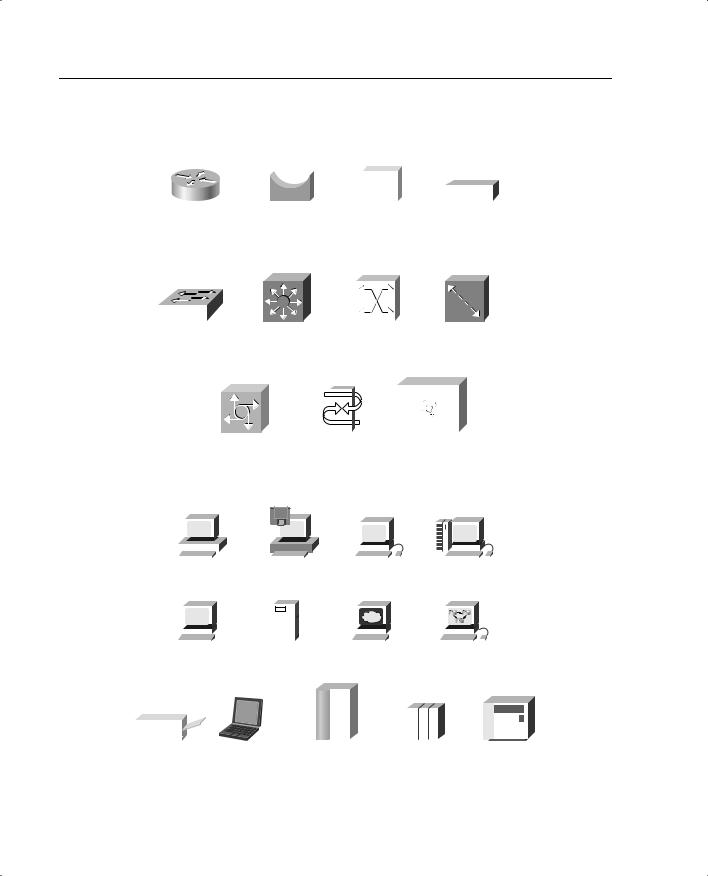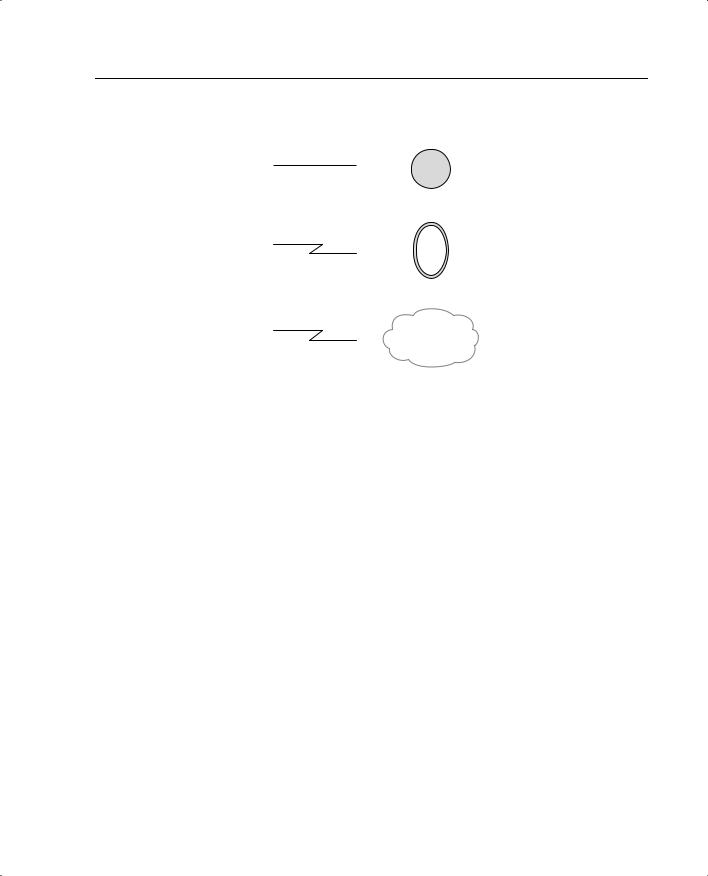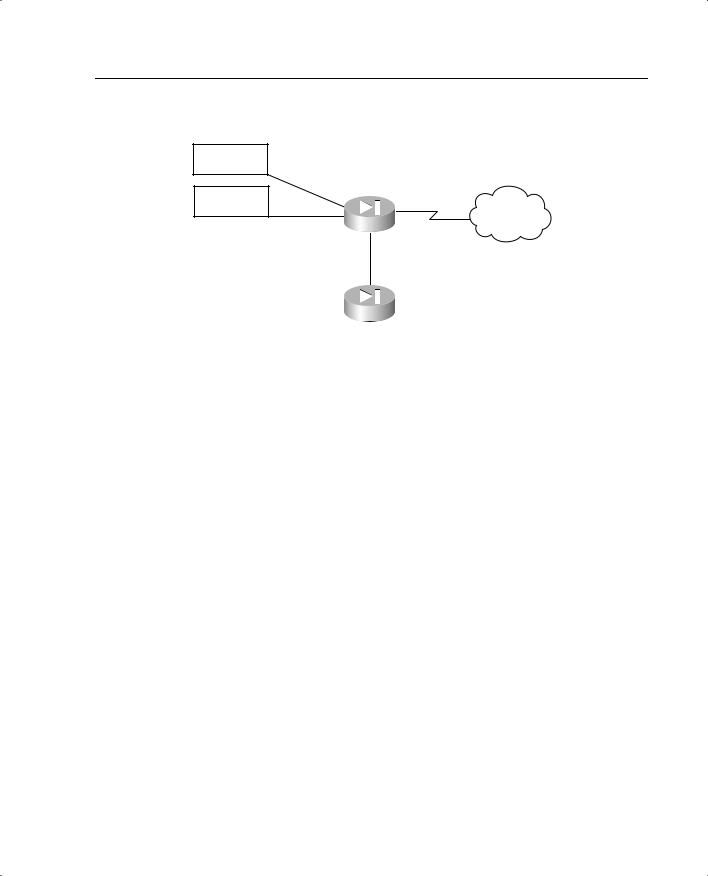
- •Icons Used in This Book
- •Network Security
- •Vulnerabilities
- •Threats
- •Types of Attacks
- •Network Security Policy
- •AVVID and SAFE
- •How to Best Use This Chapter
- •“Do I Know This Already?” Quiz
- •Foundation Topics
- •Firewall Technologies
- •Cisco PIX Firewall
- •Foundation Summary
- •The Cisco Secure PIX Firewall
- •How to Best Use This Chapter
- •“Do I Know This Already?” Quiz
- •Foundation Topics
- •Overview of the Cisco PIX Firewall
- •Cisco PIX Firewall Models and Features
- •Foundation Summary
- •System Maintenance
- •How to Best Use This Chapter
- •“Do I Know This Already?” Quiz
- •Foundation Topics
- •Accessing the Cisco PIX Firewall
- •Installing a New Operating System
- •Upgrading the Cisco PIX OS
- •Creating a Boothelper Diskette Using a Windows PC
- •Auto Update Support
- •Password Recovery
- •Foundation Summary
- •How to Best Use This Chapter
- •“Do I Know This Already?” Quiz
- •Foundation Topics
- •How the PIX Firewall Handles Traffic
- •Address Translation
- •Translation Versus Connection
- •Foundation Summary
- •“Do I Know This Already?” Quiz
- •Foundation Topics
- •Access Modes
- •Foundation Summary
- •“Do I Know This Already?” Quiz
- •Foundation Topics
- •TurboACL
- •Object Grouping
- •Advanced Protocol Handling
- •Foundation Summary
- •Syslog
- •“Do I Know This Already?” Quiz
- •Foundation Topics
- •How Syslog Works
- •How Log Messages Are Organized
- •How to Read System Log Messages
- •Disabling Syslog Messages
- •Foundation Summary
- •Cisco PIX Firewall Failover
- •“Do I Know This Already?” Quiz
- •Foundation Topics
- •What Causes a Failover Event
- •What Is Required for a Failover Configuration
- •Failover Monitoring
- •Stateful Failover
- •LAN-Based Failover
- •Foundation Summary
- •Virtual Private Networks
- •How to Best Use This Chapter
- •“Do I Know This Already?” Quiz
- •Foundation Topics
- •Overview of VPN Technologies
- •Cisco VPN Client
- •PPPoE Support
- •Foundation Summary
- •Scenario
- •Completed PIX Configurations
- •PIX Device Manager
- •“Do I Know This Already?” Quiz
- •Foundation Topics
- •PDM Overview
- •PIX Firewall Requirements to Run PDM
- •Foundation Summary
- •Content Filtering with the Cisco PIX Firewall
- •“Do I Know This Already?” Quiz
- •Filtering Java Applets
- •Filtering ActiveX Objects
- •Filtering URLs
- •Foundation Summary
- •How to Best Use This Chapter
- •“Do I Know This Already?” Quiz
- •Foundation Topics
- •Overview of AAA and the Cisco PIX Firewall
- •Cisco Secure Access Control Server (CSACS)
- •Foundation Summary
- •How to Best Use This Chapter
- •“Do I Know This Already?” Quiz
- •Foundation Topics
- •Specifying Your AAA Servers
- •Troubleshooting Your AAA Setup
- •Foundation Summary
- •“Do I Know This Already?” Quiz
- •Foundation Topics
- •Multimedia Support on the Cisco PIX Firewall
- •Attack Guards
- •PIX Firewall’s Intrusion Detection Feature
- •ip verify reverse-path Command
- •Foundation Summary
- •Answers to the “Do I Know This Already?” Quizzes and Q&A Questions
- •Chapter 1
- •Chapter 2
- •Chapter 3
- •Chapter 4
- •Chapter 5
- •Chapter 6
- •Chapter 7
- •Chapter 8
- •Chapter 9
- •Chapter 10
- •Chapter 11
- •Chapter 12
- •Chapter 13
- •Chapter 14
- •Chapter 15
- •Appendix B
- •What’s Wrong with This Picture?

CCSP Self-Study
CCSP Cisco Secure PIX Firewall
Advanced Exam Certification Guide
Cisco Press
Cisco Press
201 West 103rd Street
Indianapolis, IN 46290 USA

ii
CCSP Self-Study
CCSP Cisco Secure PIX Firewall
Advanced Exam Certification Guide
Greg Bastien, Christian Degu
Copyright© 2003 Cisco Systems, Inc.
Published by: Cisco Press
201 West 103rd Street Indianapolis, IN 46290 USA
All rights reserved. No part of this book may be reproduced or transmitted in any form or by any means, electronic or mechanical, including photocopying and recording, or by any information storage and retrieval system, without written permission from the publisher, except for the inclusion of brief quotations in a review.
Printed in the United States of America 1 2 3 4 5 6 7 8 9 0
First Printing March 2003
Library of Congress Cataloging-in-Publication Number: 2002107269
ISBN: 1-58720-067-8
Warning and Disclaimer
This book is designed to provide information about the Cisco Secure PIX Firewall Advanced Exam (CSPFA 9E0-111 and 642-521) for the Cisco Certified Security Professional. Every effort has been made to make this book as complete and accurate as possible, but no warranty or fitness is implied.
The information is provided on an “as is” basis. The authors, Cisco Press, and Cisco Systems, Inc. shall have neither liability nor responsibility to any person or entity with respect to any loss or damages arising from the information contained in this book or from the use of the discs or programs that may accompany it.
The opinions expressed in this book belong to the authors and are not necessarily those of Cisco Systems, Inc.
Feedback Information
At Cisco Press, our goal is to create in-depth technical books of the highest quality and value. Each book is crafted with care and precision, undergoing rigorous development that involves the unique expertise of members of the professional technical community.
Reader feedback is a natural continuation of this process. If you have any comments regarding how we could improve the quality of this book, or otherwise alter it to better suit your needs, you can contact us through e-mail at feedback@ciscopress.com. Please be sure to include the book title and ISBN in your message.
We greatly appreciate your assistance.

iii
Publisher |
John Wait |
Editor-In-Chief |
John Kane |
Cisco Representative |
Anthony Wolfenden |
Cisco Press Program Manager |
Sonia Torres Chavez |
Cisco Marketing Communications Manager |
Scott Miller |
Cisco Marketing Program Manager |
Edie Quiroz |
Executive Editor |
Brett Bartow |
Acquisitions Editor |
Michelle Grandin |
Production Manager |
Patrick Kanouse |
Senior Development Editor |
Christopher Cleveland |
Project Editor |
Marc Fowler |
Copy Editor |
Gayle Johnson |
Technical Editors |
Will Aranha |
|
Mesfin Goshu |
|
Jonathan Limbo |
|
Gilles Piché |
CD Content |
Jonathan Limbo |
Team Coordinator |
Tammi Ross |
Book Designer |
Gina Rexrode |
Cover Designer |
Louisa Adair |
Compositor |
Mark Shirar |
Indexer |
Larry Sweazy |
Corporate Headquarters |
European Headquarters |
Americas Headquarters |
Asia Pacific Headquarters |
|
Cisco Systems, Inc. |
Cisco Systems Europe |
Cisco Systems, Inc. |
Cisco Systems Australia, |
|
170 West Tasman Drive |
11 Rue Camille Desmoulins |
170 West Tasman Drive |
Pty., Ltd |
|
San Jose, CA 95134-1706 |
92782 Issy-les-Moulineaux |
San Jose, CA 95134-1706 |
Level 17, 99 Walker Street |
|
USA |
|
Cedex 9 |
USA |
North Sydney |
http://www.cisco.com |
France |
http://www.cisco.com |
NSW 2059 Australia |
|
Tel: |
408 526-4000 |
http://www-europe.cisco.com |
Tel: 408 526-7660 |
http://www.cisco.com |
|
800 553-NETS (6387) |
Tel: 33 1 58 04 60 00 |
Fax: 408 527-0883 |
Tel: +61 2 8448 7100 |
Fax: |
408 526-4100 |
Fax: 33 1 58 04 61 00 |
|
Fax: +61 2 9957 4350 |
Cisco Systems has more than 200 offices in the following countries. Addresses, phone numbers, and fax numbers are listed on the Cisco Web site at www.cisco.com/go/offices
Argentina • Australia • Austria • |
Belgium • Brazil |
• Bulgaria • |
Canada • Chile • China |
• |
Colombia |
• Costa |
|||
Rica • Croatia • Czech Republic • |
Denmark • Dubai, UAE • Finland • France • Germany • Greece • Hong Kong |
||||||||
Hungary • India • Indonesia • Ireland |
• Israel • |
Italy • Japan • Korea • Luxembourg • |
Malaysia |
• |
Mexico |
||||
The Netherlands • New |
Zealand • |
Norway • Peru • Philippines • Poland • Portugal • Puerto Rico • Romania |
|||||||
Russia • Saudi Arabia |
• Scotland • |
Singapore |
• Slovakia • |
Slovenia • South Africa |
• |
Spain |
• |
Sweden |
|
Switzerland • Taiwan • Thailand • Turkey • Ukraine • United Kingdom • United States • Venezuela • Vietnam Zimbabwe
Copyright © 2000, Cisco Systems, Inc. All rights reserved. Access Registrar, AccessPath, Are You Ready, ATM Director, Browse with Me, CCDA, CCDE, CCDP, CCIE, CCNA, CCNP, CCSI, CD-PAC, CiscoLink, the Cisco NetWorks logo, the Cisco Powered Network logo, Cisco Systems Networking Academy, Fast Step, FireRunner, Follow Me Browsing, FormShare, GigaStack, IGX, Intelligence in the Optical Core, Internet Quotient, IP/VC, iQ Breakthrough, iQ Expertise, iQ FastTrack, iQuick Study, iQ Readiness Scorecard, The iQ Logo, Kernel Proxy, MGX, Natural Network Viewer, Network Registrar, the Networkers logo, Packet, PIX, Point and Click Internetworking, Policy Builder, RateMUX, ReyMaster, ReyView, ScriptShare, Secure Script, Shop with Me, SlideCast, SMARTnet, SVX, TrafficDirector, TransPath, VlanDirector, Voice LAN, Wavelength Router, Workgroup Director, and Workgroup Stack are trademarks of Cisco Systems, Inc.; Changing the Way We Work, Live, Play, and Learn, Empowering the Internet Generation, are service marks of Cisco Systems, Inc.; and Aironet, ASIST, BPX, Catalyst, Cisco, the Cisco Certified Internetwork Expert Logo, Cisco IOS, the Cisco IOS logo, Cisco Press, Cisco Systems, Cisco Systems Capital, the Cisco Systems logo, Collision Free, Enterprise/Solver, EtherChannel, EtherSwitch, FastHub, FastLink, FastPAD, IOS, IP/TV, IPX, LightStream, LightSwitch, MICA, NetRanger, Post-Routing, Pre-Routing, Registrar, StrataView Plus, Stratm, SwitchProbe, TeleRouter, are registered trademarks of Cisco Systems, Inc. or its affiliates in the U.S. and certain other countries.
All other brands, names, or trademarks mentioned in this document or Web site are the property of their respective owners. The use of the word partner does not imply a partnership relationship between Cisco and any other company. (0010R)

iv
Trademark Acknowledgments
All terms mentioned in this book that are known to be trademarks or service marks have been appropriately capitalized. Cisco Press or Cisco Systems, Inc. cannot attest to the accuracy of this information. Use of a term in this book should not be regarded as affecting the validity of any trademark or service mark.

v
About the Authors
Greg Bastien, CCNP, CCSP, CISSP, currently works as a senior network security engineer for True North Solutions, Inc. as a consultant to the U.S. Department of State. He is an adjunct professor at Strayer University, teaching networking and network security classes. He completed his undergraduate and graduate degrees at Embry-Riddle Aeronautical University while on active duty as a helicopter flight instructor in the U.S. Army. He lives with his wife, two sons, and two dogs in Monrovia, Maryland.
Christian Degu, CCNP, CCDP, CCSP, currently works as a consulting engineer to the Federal Energy Regulatory Commission. He is an adjunct professor at Strayer University, teaching computer information systems classes. He has a master’s degree in computer information systems. He resides in Alexandria, Virginia.

vi
About the Technical Reviewers
Will Aranha is currently a principal security engineer with Symantec Corp. His primary job is as a technical product manager, which includes determining new product support, baselining, and providing technical training to the security engineering staff. Aranha is well-versed in many information security products and practices. Along with numerous firewall/VPN and IDS deployments, both domestic and international, he provides third-tier technical support to a 24/7 Security Operations Center, serving as a subject matter expert for all Managed Services supported products. Aranha has also contributed to the growth and success of the start-up company Riptech, Inc., which was acquired by Symantec Corp. It is now the premier security solutions provider in the market. In his free time, he has completed many industry-leading security certifications.
Mesfin Goshu, CCIE No. 8350, is a system engineer for Metrocall Wireless Inc., the second-biggest wireless company in the U.S. He is responsible for designing, maintaining, troubleshooting, and securing Metrocall’s backbone. He has been with Metrocall for almost six years. He has an extensive background in OSPF, BGP, MPLS, and network security. He has a BSc in computer and information science and civil engineering. He currently is working toward an MSc in telecommunications. As a senior network engineer, he has worked for INS and the Pentagon as a contractor. He has been in the networking field for more than nine years.
Jonathan Limbo, CCIE Security No. 10508, is currently working as a Security and VPN support engineer acting as escalation for PIX issues as well as for other security and VPN products. Jonathan has worked in the IT industry for 5 years, most of which as a Network Engineer.
Gilles Piché is a security consultant who has been working in the Network Security field in Canada for over 6 years. Prior to that, he did contract work with the Canadian government in a network engineering capacity. Gilles is also a Cisco Certified Security Instructor and has been teaching Cisco Security courses for Global Knowledge Network (Canada) for the last 2 years.

vii
Dedications
To Ingrid, Joshua, and Lukas. Thank you for putting up with me while I was locked in the office.—Greg
To my father, Aberra Degu, and my mother, Tifsehit Hailegiorgise. Thank you for inspiring me and loving me as you have. To my brother, Petros, and sisters, Hiwote and Lula, I love you guys. —Christian

viii
Acknowledgments
Writing this book has been a difficult and time-consuming yet extremely rewarding project. Many have contributed in some form or fashion to the publishing of this book. We would especially like to thank the Cisco Press team, including Michelle Grandin, Acquisitions Editor, and Christopher Cleveland, Senior Development Editor, for their guidance and encouragement throughout the entire writing process. We would also like to thank the technical reviewers, who had to endure our draft manuscripts and who helped us remain on track throughout the process.

ix
Contents at a Glance
|
Introduction xxii |
|
|
|
|
Chapter 1 |
Network Security 3 |
|
|
|
|
Chapter 2 |
Firewall Technologies and the Cisco PIX Firewall |
13 |
|||
Chapter 3 |
The Cisco Secure PIX Firewall 23 |
|
|
|
|
Chapter 4 |
System Maintenance |
47 |
|
|
|
Chapter 5 |
Understanding Cisco PIX Firewall Translation and Connections 65 |
||||
Chapter 6 |
Getting Started with the Cisco PIX Firewall |
91 |
|
||
Chapter 7 |
Configuring Access |
111 |
|
|
|
Chapter 8 |
Syslog 129 |
|
|
|
|
Chapter 9 |
Cisco PIX Firewall Failover 143 |
|
|
|
|
Chapter 10 |
Virtual Private Networks 159 |
|
|
|
|
Chapter 11 |
PIX Device Manager |
209 |
|
|
|
Chapter 12 |
Content Filtering with the Cisco PIX Firewall |
245 |
|||
Chapter 13 |
Overview of AAA and the Cisco PIX Firewall |
257 |
|||
Chapter 14 |
Configuration of AAA on the Cisco PIX Firewall |
273 |
|||
Chapter 15 |
Attack Guards and Multimedia Support |
313 |
|
|
|
Appendix A |
Answers to the “Do I Know This Already?” Quizzes and Q&A Questions 331 |
||||
Appendix B |
Case Study and Sample Configuration |
377 |
|
|
|
Glossary |
409 |
|
|
|
|
Index |
425 |
|
|
|
|

x
Contents
Introduction xxii
Chapter 1 Network Security 3
Vulnerabilities 3
Threats 4
Types of Attacks 4
Reconnaissance Attacks 5
Access Attacks 5
Denial of Service (DoS) Attacks 6
Network Security Policy 7
Step 1: Secure 8
Step 2: Monitor 8
Step 3: Test 8
Step 4: Improve 8
AVVID and SAFE 9
What Is AVVID? 9
What Is SAFE? 10
Q&A 11
Chapter 2 Firewall Technologies and the Cisco PIX Firewall 13
How to Best Use This Chapter 13
“Do I Know This Already?” Quiz 13
Foundation Topics 15
Firewall Technologies 15
Packet Filtering 15
Proxy 16
Stateful Inspection 16
Cisco PIX Firewall 17
Secure Real-Time Embedded System 17
Adaptive Security Algorithm (ASA) 17
Cut-Through Proxy 18
Redundancy 18
Foundation Summary 19
Q&A 20

xi
Chapter 3 The Cisco Secure PIX Firewall 23
How to Best Use This Chapter 23
“Do I Know This Already?” Quiz 23
Foundation Topics 25
Overview of the Cisco PIX Firewall 25
Adaptive Security Algorithm (ASA) 25
Cut-Through Proxy 26
Cisco PIX Firewall Models and Features 27
Intrusion Protection 28
AAA Support 28
X.509 Certificate Support 28
Network Address Translation/Port Address Translation 29
Firewall Management 29
Simple Network Management Protocol (SNMP) 29
Syslog Support 30
Virtual Private Networks (VPNs) 30
Cisco Secure PIX 501 30
Cisco Secure PIX 506 31
Cisco Secure PIX 515 33
Cisco Secure PIX 520 35
Cisco Secure PIX 525 38
Cisco Secure PIX 535 39
Foundation Summary 42
Q&A 44
Chapter 4 System Maintenance 47
How to Best Use This Chapter 47
“Do I Know This Already?” Quiz 47
Foundation Topics 48
Accessing the Cisco PIX Firewall 48
Accessing the Cisco PIX Firewall with Telnet 48
Accessing the Cisco PIX Firewall with Secure Shell (SSH) 49
Installing a New Operating System 50
Upgrading Your Activation Key 51
Upgrading the Cisco PIX OS 53
Upgrading the OS Using the copy tftp flash Command 53
Upgrading the OS Using Monitor Mode 54
Upgrading the OS Using an HTTP Client 56

xii
Creating a Boothelper Diskette Using a Windows PC 56
Auto Update Support 57
Password Recovery 58
Cisco PIX Firewall Password Recovery: Getting Started 58
Password Recovery Procedure for a PIX with a Floppy Drive (PIX 520) 59 Password Recovery Procedure for a Diskless PIX (PIX 501, 506, 515, 525, and 535) 59
Foundation Summary 60
Q&A 61
Chapter 5 Understanding Cisco PIX Firewall Translation and Connections 65
How to Best Use This Chapter 65
“Do I Know This Already?” Quiz 65
Foundation Topics 67
How the PIX Firewall Handles Traffic 67
Interface Security Levels and the Default Security Policy 67
Transport Protocols 67
Address Translation 71
Translation Commands 73
Network Address Translation 74
Port Address Translation 75
Static Translation 75
Using the static Command for Port Redirection 77
Configuring Multiple Translation Types on the Cisco PIX Firewall 77
Bidirectional Network Address Translation 79
Translation Versus Connection 79
Configuring DNS Support 82
Foundation Summary 83
Q&A 87
Chapter 6 Getting Started with the Cisco PIX Firewall 91
“Do I Know This Already?” Quiz 91
Foundation Topics 92
Access Modes 92
Configuring the PIX Firewall 92 interface Command 93 nameif Command 94

xiii
ip address Command 95 nat Command 96 global Command 96 route Command 98
RIP 98
Testing Your Configuration 99 Saving Your Configuration 100
Configuring DHCP on the Cisco PIX Firewall 100
Using the PIX Firewall DHCP Server 101
Configuring the PIX Firewall DHCP Client 102
Configuring Time Settings on the Cisco PIX Firewall 102
Network Time Protocol (NTP) 102
PIX Firewall System Clock 104
Sample PIX Configuration 105
Foundation Summary 107
Q&A 108
Chapter 7 Configuring Access 111
“Do I Know This Already?” Quiz 111
Foundation Topics 112
Configuring Inbound Access Through the PIX Firewall 112 Static Network Address Translation 112
Static Port Address Translation 113 TCP Intercept Feature 114
nat 0 Command 115 Access Lists 115
TurboACL 118
Configuring Individual TurboACL 119
Globally Configuring TurboACL 119
Object Grouping 119 network object-type 120 protocol object-type 121 service object-type 121 icmp-type object-type 121
Nesting Object Groups 122
Using the fixup Command 122

xiv
Advanced Protocol Handling 123
File Transfer Protocol (FTP) 123
Multimedia Support 124
Foundation Summary 125
Q&A 126
Chapter 8 Syslog 129
“Do I Know This Already?” Quiz 129
Foundation Topics 130
How Syslog Works 130
Logging Facilities 131
Logging Levels 131
Configuring Syslog on the Cisco PIX Firewall 132 Configuring the PIX Device Manager to View Logging 133 Configuring Syslog Messages at the Console 134
Viewing Messages in a Telnet Console Session 134
Configuring the Cisco PIX Firewall to Send Syslog Messages to a Log Server 134
Configuring a Syslogd Server 135
PIX Firewall Syslog Server (PFSS) 136
Configuring SNMP Traps and SNMP Requests 136
How Log Messages Are Organized 137
How to Read System Log Messages 138
Disabling Syslog Messages 138
Foundation Summary 139
Q&A 140
Chapter 9 Cisco PIX Firewall Failover 143
“Do I Know This Already?” Quiz 143
Foundation Topics 145
What Causes a Failover Event 145
What Is Required for a Failover Configuration 145
Failover Monitoring 146
Configuration Replication 147
Stateful Failover 148
LAN-Based Failover 149

xv
Configuring Failover 150
Foundation Summary 155
Q&A 156
Chapter 10 Virtual Private Networks 159
How to Best Use This Chapter 159
“Do I Know This Already?” Quiz 159
Foundation Topics 161
Overview of VPN Technologies 161
Internet Protocol Security (IPSec) 162
Internet Key Exchange (IKE) 164
Certification Authorities (CAs) 167
Configuring the PIX Firewall as a VPN Gateway 168
Selecting Your Configuration 168
Configuring IKE 169
Configuring IPSec 173
Troubleshooting Your VPN Connection 180
Cisco VPN Client 184 VPN Groups 185
Point-to-Point Tunneling Protocol (PPTP) and Layer 2 Tunneling Protocol (L2TP) 185
Configuring PIX Firewalls for Scalable VPNs 187
PPPoE Support 188
Foundation Summary 189
Q&A 191
Scenario 192
VPN Configurations 192
Los Angeles Configuration 198
Boston Configuration 199
Atlanta Configuration 199
Completed PIX Configurations 201
How the Configuration Lines Interact 206
Chapter 11 PIX Device Manager 209
“Do I Know This Already?” Quiz 209
Foundation Topics 210

xvi
PDM Overview 210
PIX Firewall Requirements to Run PDM 211
PDM Operating Requirements 212
Browser Requirements 212
Windows Requirements 212
SUN Solaris Requirements 213
Linux Requirements 213
PDM Installation and Configuration 213
Using the PDM to Configure the Cisco PIX Firewall 214
Using PDM for VPN Configuration 227
Using PDM to Create a Site-to-Site VPN 227
Using PDM to Create a Remote-Access VPN 232
Foundation Summary 240
Q&A 242
Chapter 12 Content Filtering with the Cisco PIX Firewall 245
“Do I Know This Already?” Quiz 245
Filtering Java Applets 246
Filtering ActiveX Objects 248
Filtering URLs 248
Identifying the Filtering Server 248
Configuring Filtering Policy 249
Filtering Long URLs 251
Viewing Filtering Statistics and Configuration 251
Foundation Summary 253
Q&A 254
Chapter 13 Overview of AAA and the Cisco PIX Firewall 257
How to Best Use This Chapter 257
“Do I Know This Already?” Quiz 257
Foundation Topics 259
Overview of AAA and the Cisco PIX Firewall 259
Definition of AAA 259
AAA and the Cisco PIX Firewall 260
Cut-Through Proxy 260
Supported AAA Server Technologies 262

xvii
Cisco Secure Access Control Server (CSACS) 262
Minimum Hardware and Operating System Requirements for CSACS 262 Installing CSACS on Windows 2000/NT Server 263
Foundation Summary 269
Q&A 270
Chapter 14 Configuration of AAA on the Cisco PIX Firewall 273
How to Best Use This Chapter 273
“Do I Know This Already?” Quiz 273
Foundation Topics 275
Specifying Your AAA Servers 275
Configuring AAA on the Cisco PIX Firewall 276
Step 1: Identifying the AAA Server and NAS 276
Step 2: Configuring Authentication 279
Step 3: Configuring Authorization 287
Step 4: Configuring Accounting 295
Cisco Secure and Cut-Through Configuration 300
Configuring Downloadable PIX ACLs 300
Troubleshooting Your AAA Setup 303
Checking the PIX Firewall 304
Checking the CSACS 306
Foundation Summary 307
Q&A 309
Chapter 15 Attack Guards and Multimedia Support 313
“Do I Know This Already?” Quiz 313
Foundation Topics 314
Multimedia Support on the Cisco PIX Firewall 314
Real-Time Streaming Protocol (RTSP) 315
H.323 315
Attack Guards 317
Fragmentation Guard and Virtual Reassembly 317
Domain Name System (DNS) Guard 318
Mail Guard 319
Flood Defender 320
AAA Floodguard 320

xviii
PIX Firewall’s Intrusion Detection Feature 321
Intrusion Detection Configuration 322
Dynamic Shunning 323
ip verify reverse-path Command 324
Foundation Summary 326
Q&A 327
Appendix A Answers to the “Do I Know This Already?” Quizzes and Q&A Questions 331
Chapter 1 331
Q&A 331
Chapter 2 331
“Do I Know This Already?” Quiz 331
Q&A 333
Chapter 3 334
“Do I Know This Already?” Quiz 334
Q&A 335
Chapter 4 336
“Do I Know This Already?” Quiz 336
Q&A 337
Chapter 5 339
“Do I Know This Already?” Quiz 339
Q&A 340
Chapter 6 342
“Do I Know This Already?” Quiz 342
Q&A 343
Chapter 7 345
“Do I Know This Already?” Quiz 345
Q&A 346
Chapter 8 348
“Do I Know This Already?” Quiz 348
Q&A 349
Chapter 9 350
“Do I Know This Already?” Quiz 350
Q&A 351
Chapter 10 354
“Do I Know This Already?” Quiz 354
Q&A 355

xix
Chapter 11 356
“Do I Know This Already?” Quiz 356
Q&A 357
Chapter 12 359
“Do I Know This Already?” Quiz 359
Q&A 360
Chapter 13 363
“Do I Know This Already?” Quiz 363
Q&A 364
Chapter 14 365
“Do I Know This Already?” Quiz 365
Q&A 366
Chapter 15 368
“Do I Know This Already?” Quiz 368
Q&A 369
Appendix B 371
Appendix B Case Study and Sample Configuration 377
Task 1: Basic Configuration for the Cisco PIX Firewall 380
Basic Configuration Information for PIX HQ 380
Basic Configuration Information for PIX Minneapolis 382
Basic Configuration Information for PIX Houston 383
Task 2: Configuring Access Rules on HQ 385
Task 3: Configuring Authentication 385
Task 4: Configuring Logging 386
Task 5: Configuring VPN 386
Configuring the Central PIX Firewall, HQ_PIX, for VPN Tunneling 386 Configuring the Houston PIX Firewall, HOU_PIX, for VPN Tunneling 389 Configuring the Minneapolis PIX Firewall, MN_PIX, for VPN Tunneling 392 Verifying and Troubleshooting 394
Task 6: Configuring Failover 395
What’s Wrong with This Picture? 398
Glossary 409
Index 425

xx
Icons Used in This Book
Throughout this book, you will see the following icons used for networking devices:
|
|
|
|
|
|
|
|
|
|
|
|
|
|
|
|
|
|
|
|
|
|
|
|
DSU/CSU |
|
Router |
Bridge |
|
Hub |
|
DSU/CSU |
|||||||
|
|
|
|
|
|
|
|
|
|
|
|
|
|
|
|
|
|
|
|
|
|
|
|
|
|
|
|
|
|
|
|
|
|
|
|
|
|
|
|
|
|
|
|
|
|
|
|
|
|
|
|
|
|
|
|
|
|
|
|
|
|
|
|
|
|
|
|
|
|
|
|
|
|
|
|
|
|
|
|
|
|
|
|
|
|
|
|
|
|
|
Catalyst |
|
|
Multilayer |
|
ATM |
|
|
ISDN/Frame Relay |
|||||
Switch |
|
|
Switch |
|
Switch |
|
|
|
|
|
Switch |
||
|
|
|
|
|
|
|
|
|
|
|
|
|
|
|
|
|
|
|
|
|
|
|
|
|
|
|
|
|
|
|
|
|
|
|
|
|
|
|
|
|
|
|
|
|
|
|
|
|
|
|
|
|
|
|
|
|
|
|
|
|
|
|
|
|
|
|
|
|
|
|
|
|
|
|
|
|
|
|
|
|
|
|
|
Communication |
Gateway |
Access |
Server |
|
Server |
The following icons are used for peripherals and other devices:
|
|
|
|
|
|
|
|
|
|
|
|
|
|
|
|
|
|
|
|
|
|
|
|
|
|
|
|
|
|
|
|
|
|
|
|
|
|
|
|
|
|
|
|
|
|
|
|
|
|
|
|
|
|
|
|
|
|
|
|
|
|
|
|
|
|
|
|
|
|
|
|
|
|
|
|
|
|
|
|
|
|
|
|
|
|
|
|
|
|
|
|
|
|
|
|
|
|
|
|
|
|
|
|
|
|
|
|
|
|
|
|
|
|
|
|
|
|
|
|
|
|
|
|
|
|
|
|
|
|
|
|
|
|
|
|
|
|
|
|
|
|
|
|
|
PC |
|
PC with |
|
Sun |
Macintosh |
|||||||||||||||||
|
|
|
|
Software |
Workstation |
|
|
|
|
|
|
|
|||||||||||
|
|
|
|
|
|
|
|
|
|
|
|
|
|
|
|
|
|
|
|
|
|
|
|
|
|
|
|
|
|
|
|
|
|
|
|
|
|
|
|
|
|
|
|
|
|
|
|
|
|
|
|
|
|
|
|
|
|
|
|
|
|
|
|
|
|
|
|
|
|
|
|
|
|
|
|
|
|
|
|
|
|
|
|
|
|
|
|
|
|
|
|
|
|
|
|
|
|
|
|
|
|
|
|
|
|
|
|
|
|
|
|
|
|
|
|
|
|
|
|
Terminal |
|
|
|
|
|
|
|
File |
|
|
Web |
|
Cisco Works |
||||||||
|
|
|
|
|
|
|
|
|
Server |
|
|
Server |
|
Workstation |
|||||||
|
|
|
|
|
|
|
|
|
|
|
|
|
|
|
|
|
|
|
|
|
|
|
|
|
|
|
|
|
|
|
|
|
|
|
|
|
|
|
|
|
|
|
|
|
|
|
|
|
|
|
|
|
|
|
|
|
|
|
|
|
|
|
|
|
|
|
|
|
|
|
|
|
|
|
|
|
|
|
|
|
|
|
|
|
|
|
|
|
|
|
|
|
|
|
|
|
|
|
|
|
|
|
|
|
|
|
|
|
|
|
|
|
|
|
|
|
|
|
|
|
|
|
|
|
|
|
|
|
|
|
|
|
|
|
|
|
|
|
|
|
|
|
|
|
|
|
|
|
|
|
|
|
|
Printer |
Laptop |
IBM |
Front End |
Cluster |
|
|
Mainframe |
Processor |
Controller |

xxi
The following icons are used for networks and network connections:
Token
Ring
Line: Ethernet
Token Ring
FDDI
Line: Serial
FDDI
Line: Switched Serial
Network Cloud

xxii
Introduction
The primary goal of this book is to help you prepare to pass either the 9E0-111 or 642-521 Cisco Secure PIX Firewall Advanced (CSPFA) exams as you strive to attain the CCSP certification, or a focused PIX certification.
Who Should Read This Book?
Network security is a very complex business. The Cisco PIX Firewall performs some very specific functions as part of the security process. It is very important to be familiar with many networking and network security concepts before you undertake the CSPFA certification. This book is designed for security professionals or networking professionals who are interested in beginning the security certification process.
How to Use This Book
This book consists of 15 chapters. Each one builds on the preceding chapter. The chapters that cover specific commands and configurations include case studies or practice configurations. Appendix B includes an additional “master” case study that combines many different topics. It also has a section with configuration examples that might or might not work. It is up to you to determine if the configurations fulfill the requirements and why.
The chapters cover the following topics:
•Chapter 1, “Network Security”—This chapter provides an overview of network security—the process and potential threats. It also discusses how network security has become increasingly important to businesses as companies continue to become more intertwined and their network perimeters continue to fade. Chapter 1 discusses the network security policy and two Cisco programs that can help companies design and implement sound security policies, processes, and architecture.
•Chapter 2, “Firewall Technologies and the Cisco PIX Firewall”—This chapter covers the different firewall technologies and the Cisco PIX Firewall. It examines the design of the PIX Firewall and discusses some of that design’s security advantages.
•Chapter 3, “The Cisco Secure PIX Firewall”—Chapter 3 deals with the design of the Cisco PIX Firewall in greater detail. It lists the different PIX models and their intended applications and discusses the various features available with each model and how each model should be implemented.
•Chapter 4, “System Maintenance”—Chapter 4 discusses the installation and configuration of the Cisco PIX Firewall OS. It covers the different configuration options that allow for remote management of the PIX.
•Chapter 5, “Understanding Cisco PIX Firewall Translation and Connections”—This chapter covers the different transport protocols and how the PIX Firewall handles them. It also discusses network addressing and how the PIX can alter node or network addresses to secure those elements.
•Chapter 6, “Getting Started with the Cisco PIX Firewall”—This is where we really begin to get to the “meat” of the PIX. This chapter covers the basic commands required to make the PIX operational. It discusses the methods of connecting to the PIX Firewall and some of the many configuration options available with the PIX.
•Chapter 7, “Configuring Access”—This chapter covers the different configurations that allow you to control access to your network(s) using the PIX Firewall. It also covers some of the specific configurations required to allow certain protocols to pass through the firewall.

xxiii
•Chapter 8, “Syslog”—Chapter 8 covers the PIX Firewall’s logging functions and the configuration required to allow the PIX Firewall to log in to a syslog server.
•Chapter 9, “Cisco PIX Firewall Failover”—This chapter discusses the advantages of a redundant firewall configuration and the steps required to configure two PIX firewalls in failover mode.
•Chapter 10, “Virtual Private Networks”—Many businesses have multiple locations that need to be interconnected. Chapter 10 explains the different types of secure connections of virtual private networks that can be configured between the PIX Firewall and other VPN endpoints. It covers the technologies and protocols used to create and maintain VPNs across public networks.
•Chapter 11, “PIX Device Manager”—The Cisco PIX Firewall can be managed using a variety of tools. Chapter 11 discusses the PIX Device Manager, a web-based graphical user interface (GUI) that can be used to manage the PIX.
•Chapter 12, “Content Filtering with the Cisco PIX Firewall”—It is a common practice for hackers to embed attacks into the content of a web page. Certain types of program code are especially conducive to this type of attack due to their interactive nature. This chapter discusses these types of code and identifies their dangers. It also covers the different PIX configurations for filtering potentially malicious traffic passing through the firewall.
•Chapter 13, “Overview of AAA and the Cisco PIX Firewall”—It is extremely important to ensure that only authorized users access your network. Chapter 13 discusses the different methods of configuring the PIX Firewall to interact with authentication, authorization, and accounting (AAA) services. This chapter also introduces the Cisco Secure Access Control Server (CSACS), which is Cisco’s AAA server package.
•Chapter 14, “Configuration of AAA on the Cisco PIX Firewall”—This chapter discusses the specific configuration on the PIX Firewall for communication with the AAA server, including the CSACS. It covers the implementation, functionality, and troubleshooting of AAA on the PIX Firewall.
•Chapter 15, “Attack Guards and Multimedia Support”—Many different attacks can be launched against a network and its perimeter security devices. This chapter explains some of the most common attacks and how the PIX Firewall can be configured to repel them.
Each chapter follows the same format and incorporates the following features to assist you by assessing your current knowledge and emphasizing specific areas of interest within the chapter:
•“Do I Know This Already?” Quiz—Each chapter begins with a quiz to help you assess your current knowledge of the subject. The quiz is broken into specific areas of emphasis that allow you to determine where to focus your efforts when working through the chapter.
•Foundation Topics—This is the core section of each chapter. It focuses on the specific protocol, concept, or skills you must master to successfully prepare for the examination.
•Foundation Summary—Near the end of each chapter, the foundation topics are summarized into important highlights from the chapter. In many cases, the foundation summaries include tables, but in some cases the important portions of each chapter are simply restated to emphasize their importance within the subject matter. Remember that the foundation portions are in the book to assist you with your exam preparation. It is very unlikely that you will be able to successfully complete the certification exam by just studying the foundation topics and foundation summaries, although they are a good tool for last-minute preparation just before taking the exam.
•Q&A—Each chapter ends with a series of review questions to test your understanding of the material covered. These questions are a great way to ensure that you not only understand the material but also exercise your ability to recall facts.

xxiv
•Case Studies/Scenarios—The chapters that deal more with configuring the Cisco PIX Firewall have brief scenarios. These scenarios help you understand the different configuration options and how each component can affect another component within the firewall configuration. Two case studies near the end of the book allow you to practice configuring the firewall to perform specific functions. There is also a section that includes configurations that might or might not work. You are asked to determine if the configuration will work correctly, and why or why not. Because the certification exam asks specific questions about configuring the Cisco PIX Firewall, it is very important to become intimately familiar with the different commands and components of the PIX configuration.
•CD-based practice exam—On the CD included with this book, you’ll find a practice test with more than 200 questions that cover the information central to the CSPFA exam. With our customizable testing engine, you can take a sample exam, either focusing on particular topic areas or randomizing the questions. Each test question includes a link that points to a related section in an electronic PDF copy of the book, also included on the CD.
The Certification Exam and This Preparation Guide
The questions for each certification exam are a closely guarded secret. But even if you obtained the questions and passed the exam, you would be in for quite an embarrassment as soon as you arrived at your first job that required PIX skills. The point is to know the material, not just to successfully pass the exam. We know what topics you must understand to pass the exam. Coincidentally, these are the same topics required for you to be proficient with the PIX Firewall. We have broken these into “foundation topics” and cover them throughout this book. Table I-1 describes each foundation topic.
Table I-1 |
CSPFA Foundation Topics |
|
|
|
|
Reference |
|
|
Number |
Exam Topic |
Description |
|
|
|
1 |
Firewalls |
Firewalls process network traffic in three different ways. Chapter 2 |
|
|
discusses these technologies and their advantages. |
|
|
|
2 |
PIX Firewall overview |
Chapter 2 explains the PIX Firewall’s design and its advantages |
|
|
compared to other firewall products. |
|
|
|
3 |
PIX Firewall models |
Currently, the PIX Firewall has six different models. Chapter 3 |
|
|
discusses each model, its specifications, and how and when it is |
|
|
applied. |
|
|
|
4 |
PIX Firewall licensing |
Chapter 3 discusses the different licensing options available for the |
|
|
PIX Firewall and how each license applies. |
|
|
|
5 |
User interface |
The CLI is one of the methods used to configure the PIX Firewall. |
|
|
Chapter 6 covers the CLI and many of the commands used to configure |
|
|
the firewall. |
|
|
|
6 |
Configuring the PIX |
Many different commands are used to configure the PIX Firewall. |
|
Firewall |
These commands are discussed in Chapters 6 through 15. |
|
|
|
7 |
Examining the PIX |
Verifying the configuration of the PIX Firewall helps you troubleshoot |
|
Firewall status |
connectivity issues. |
|
|
|

|
|
xxv |
|
|
|
|
|
Table I-1 |
CSPFA Foundation Topics (Continued) |
||
|
|
|
|
Reference |
|
|
|
Number |
Exam Topic |
Description |
|
|
|
|
|
8 |
Time setting and NTP |
It is important to ensure that your firewall time is synchronized with |
|
|
support |
your network. Chapter 6 covers the commands for configuring time on |
|
|
|
the PIX Firewall. |
|
|
|
|
|
9 |
ASA security levels |
The Adaptive Security Algorithm is a key component of the PIX |
|
|
|
Firewall. It is discussed in great detail in Chapters 2, 3, 5, and 6. |
|
|
|
|
|
10 |
Basic PIX Firewall |
The basic configuration of the PIX Firewall is discussed in Chapter 6. |
|
|
configuration |
|
|
|
|
|
|
11 |
Syslog configuration |
The logging features of the PIX Firewall are covered in Chapter 8. |
|
|
|
|
|
12 |
Routing configuration |
Because the firewall operates at multiple layers of the OSI model, it |
|
|
|
can route traffic as well as filter it. The route commands for the PIX |
|
|
|
Firewall are discussed in Chapter 6. |
|
|
|
|
|
13 |
DHCP server |
The PIX Firewall can function as both a DHCP server and a DHCP |
|
|
configuration |
client. These configurations are covered in Chapters 3 and 6. |
|
|
|
|
|
14 |
Transport Protocols |
The transport layer protocols and how they are handled by the PIX |
|
|
|
Firewall are discussed in Chapter 5. |
|
|
|
|
|
15 |
Network Address |
Network Address Translation is used by many different firewalls to |
|
|
Translation |
secure network segments. This is discussed in Chapters 5 and 6. |
|
|
|
|
|
16 |
Port Address |
Port Address Translation is a method used by the PIX Firewall to NAT |
|
|
Translations |
multiple internal sources to a single external address. This |
|
|
|
configuration is covered in Chapters 5 and 6. |
|
|
|
|
|
17 |
Configuring DNS |
As a perimeter device, the PIX Firewall must support the Domain |
|
|
support |
Name Service. Configuring DNS on the PIX is discussed in Chapter 5. |
|
|
|
|
|
18 |
ACLs |
Access control lists are used to allow or deny traffic between different |
|
|
|
network segments that attach via the PIX Firewall. Configuring ACLs |
|
|
|
is discussed in Chapter 7. |
|
|
|
|
|
19 |
Using ACLs |
Configuring ACLs is discussed in Chapter 7. |
|
|
|
|
|
20 |
URL filtering |
The PIX Firewall can be configured to work with other products to |
|
|
|
perform URL content filtering. This is done to ensure that users use |
|
|
|
company assets in accordance with company policies. Configuring the |
|
|
|
PIX for content filtering is discussed in Chapter 12. |
|
|
|
|
|
21 |
Overview of object |
Service, host, and network objects can be grouped to make processing |
|
|
grouping |
by the firewall more efficient. Object grouping is discussed in Chapter |
|
|
|
7. |
|
|
|
|
|
22 |
Getting started with |
Object grouping is discussed in Chapter 7. |
|
|
group objects |
|
|
|
|
|
|
23 |
Configuring group |
Object grouping is discussed in Chapter 7. |
|
|
objects |
|
|
|
|
|
|

xxvi
Table I-1 |
CSPFA Foundation Topics (Continued) |
|
|
|
|
Reference |
|
|
Number |
Exam Topic |
Description |
|
|
|
24 |
Nested object groups |
Object groups can be nested into other object groups. Object grouping |
|
|
is discussed in Chapter 7. |
|
|
|
25 |
Advanced protocols |
Many advanced protocols require special handling by the firewall. |
|
|
Some protocols require multiple inbound and outbound connections. |
|
|
The handling of advanced protocols by the PIX Firewall is discussed in |
|
|
Chapter 7. |
|
|
|
26 |
Multimedia support |
Multimedia protocols are considered advanced protocols. The handling |
|
|
of advanced protocols by the PIX Firewall is discussed in Chapter 7. |
|
|
|
27 |
Attack guards |
The PIX Firewall can be configured to recognize an attack and react to |
|
|
it. This is covered in Chapter 15. |
|
|
|
28 |
Intrusion detection |
The PIX Firewall can be configured to perform as an Intrusion |
|
|
Detection System as well as a firewall. It also can be configured to |
|
|
work with external IDSs. These issues are covered in Chapter 15. |
|
|
|
29 |
Overview of AAA |
AAA is a method of ensuring that you can verify who is accessing your |
|
|
network resources, restrict their access to specific resources, and keep |
|
|
track of what actions they take on the network. Configuring the PIX |
|
|
Firewall to support AAA is discussed in Chapters 13 and 14. |
|
|
|
30 |
Installation of CSACS |
CSACS is a Cisco AAA server product. Installing and configuring |
|
for Windows NT/2000 |
CSACS is covered in Chapter 13. |
|
|
|
31 |
Authentication |
Configuring CSACS is discussed in Chapters 13 and 14. |
|
configuration |
|
|
|
|
32 |
Downloadable ACLs |
Configuring CSACS is discussed in Chapters 13 and 14. |
|
|
|
33 |
Understanding |
Mission-critical systems require high-availability solutions to |
|
failover |
minimize any chance of network outages. Two PIX firewalls can be |
|
|
configured as a high-availability solution. This configuration is covered |
|
|
in Chapter 9. |
|
|
|
34 |
Failover configuration |
PIX failover configuration is discussed in Chapter 9. |
|
|
|
35 |
LAN-based failover |
PIX failover configuration is discussed in Chapter 9. |
|
configuration |
|
|
|
|
36 |
PIX Firewall enables a |
Dedicated circuits between different locations can be cost-prohibitive. |
|
secure VPN |
It is much less expensive and just as secure to create an encrypted |
|
|
connection between those locations across public network space. |
|
|
Configuring virtual private networks is discussed in Chapter 10. |
|
|
|
37 |
IPSec configuration |
Configuring virtual private networks is discussed in Chapter 10. |
|
tasks |
|
|
|
|
38 |
Prepare to configure |
Both ends of a virtual private network must have a termination point. |
|
VPN support |
The PIX Firewall can be configured as a VPN termination point. |
|
|
Configuring virtual private networks is discussed in Chapter 10. |
|
|
|

xxvii
Table I-1 |
CSPFA Foundation Topics (Continued) |
|
|
|
|
Reference |
|
|
Number |
Exam Topic |
Description |
|
|
|
39 |
Configure IKE |
IKE is a key exchange method used to ensure that the encrypted |
|
parameters |
connection is not easily compromised. |
|
|
Configuring virtual private networks is discussed in Chapter 10. |
|
|
|
40 |
Configure IPSec |
IP Security (IPSec) is a standard for creating an encrypted VPN |
|
parameters |
connection. Configuring virtual private networks is discussed in |
|
|
Chapter 10. |
|
|
|
41 |
Test and verify VPN |
Configuration and troubleshooting of Virtual Private Networks is |
|
configuration |
discussed in Chapter 10. |
|
|
|
42 |
Cisco VPN Client |
Remote users can create a VPN from their computers to the company |
|
|
network using VPN client software. Configuring virtual private |
|
|
networks and VPN client software is discussed in Chapter 10. |
|
|
|
43 |
Scale PIX Firewall |
Configuring virtual private networks is discussed in Chapter 10. |
|
VPNs |
|
|
|
|
44 |
PPPoE and the PIX |
PPPoE is used to connect multiple hosts via a single dialup or |
|
Firewall |
broadband connection. Some PIX Firewall models support PPPoE. |
|
|
This topic is covered in Chapter 10. |
|
|
|
45 |
Remote access |
The PIX Firewall can be managed either locally or remotely. |
|
|
Configuring the PIX to allow remote access is discussed in Chapter 4. |
|
|
|
46 |
Command-level |
Remote management of the PIX Firewall is discussed in Chapter 4. |
|
authorization |
|
|
|
|
47 |
PDM overview |
The PIX Device Manager (PDM) is a web-enabled tool for remote |
|
|
management of the PIX Firewall. Remote management of the PIX |
|
|
using the PDM is discussed in Chapter 11. |
|
|
|
48 |
PDM operating |
The PIX Device Manager (PDM) is a web-enabled tool for remote |
|
requirements |
management of the PIX Firewall. Remote management of the PIX |
|
|
using the PDM is discussed in Chapter 11. |
|
|
|
49 |
Prepare for PDM |
The PIX Device Manager (PDM) is a web-enabled tool for remote |
|
|
management of the PIX Firewall. Remote management of the PIX |
|
|
using the PDM is discussed in Chapter 11. |
|
|
|
50 |
Using PDM to |
The PIX Device Manager (PDM) is a web-enabled tool for remote |
|
configure the PIX |
management of the PIX Firewall. Remote management of the PIX |
|
Firewall |
using the PDM is discussed in Chapter 11. |
|
|
|
51 |
Using PDM to create |
The PIX Device Manager (PDM) is a web-enabled tool for remote |
|
a site-to-site VPN |
management of the PIX Firewall. Remote management of the PIX |
|
|
using the PDM is discussed in Chapter 11. |
|
|
|
52 |
Using PDM to create |
The PIX Device Manager (PDM) is a web-enabled tool for remote |
|
a remote access VPN |
management of the PIX Firewall. Remote management of the PIX |
|
|
using the PDM is discussed in Chapter 11. |
|
|
|

xxviii
Overview of the Cisco Certification Process
The network security market is currently in a position where the demand for qualified engineers vastly exceeds the supply. For this reason, many engineers consider migrating from routing/networking to network security. Remember that network security is simply security applied to networks. This sounds like an obvious concept, but it is a very important one if you are pursuing your security certification. You must be very familiar with networking before you can begin applying security concepts. All CCSP candidates must first pass the Cisco Certified Networking Associate (CCNA) exam. The skills required to complete the CCNA give you a solid foundation that you can expand into the Network Security field.
Table 1-2 contains a list of the exams in the CCSP certification series. Because all exam information is managed by Cisco Systems and is therefore subject to change, candidates should continually monitor the Cisco Systems site for course and exam updates at www.cisco.com/go/training.
Table I-2 |
CCSP Certification Exams |
|
|
|
|
|
|
|
Exam Number |
Exam Name |
Comments on Upcoming Exam Changes |
|
|
|
|
|
640-100 |
MCNS 3.0, Managing |
In Summer 2003, a new exam, SECUR 642-501, |
|
|
Cisco Network |
will become available. This exam will eventually |
|
|
Security |
replace the 640-100 exam. If recertification |
|
|
|
candidates pass this exam, they will be considered |
|
|
|
recertified at the CCNA or CCDA level. |
|
|
|
|
|
9E0-111 |
CSPFA 3.0, Cisco |
By Summer 2003, a new exam will be available |
|
|
Secure PIX Firewall |
to certification candidates taking the PIX exam: |
|
|
Advanced Exam |
642-521. Note that the renumbering signifies that |
|
|
|
those passing this exam will be considered |
|
|
|
recertified at the CCNA or CCDA level. There are |
|
|
|
no significant changes between the 9E0-111 exam |
|
|
|
and the 642-521 exam. |
|
|
|
|
|
9E0-100 |
CSIDS 3.0, Cisco |
There are no anticipated changes to this exam as of |
|
|
Secure Intrusion |
the time that this book was printed. Be sure to refer |
|
|
Detection Systems |
to the Cisco Systems website for current |
|
|
|
information regarding exam numbers and content. |
|
|
|
|
|
9E0-121 |
CSVPN 3.0, Cisco |
By Summer 2003, a new exam will be available |
|
|
Secure Virtual Private |
to certification candidates taking the VPN exam: |
|
|
Networks |
642-511. Note that the renumbering signifies that |
|
|
|
those passing this exam will be considered |
|
|
|
recertified at the CCNA or CCDA level. There are |
|
|
|
no significant changes between the 9E0-121 exam |
|
|
|
and the 642-511 exam. |
|
|
|
|
|
9E0-131 |
CSI 1.0, Cisco SAFE |
There are no anticipated changes to this exam as of |
|
|
Implementation |
the time that this book was printed. Be sure to refer |
|
|
|
to the Cisco Systems website for current |
|
|
|
information regarding exam numbers and content. |
|
|
|
|

xxix
Taking the CSPFA Certification Exam
As with any Cisco certification exam, it is best to be thoroughly prepared before taking the exam. There is no way to determine exactly what questions are on the exam, so the best way to prepare is to have a good working knowledge of all subjects covered on the exam. Schedule yourself for the exam, and be sure to be rested and ready to focus before taking the exam.
The best place to find the latest available Cisco training and certifications is www.cisco.com/go/training.
Tracking CCSP Status
You can track your certification progress by checking the Certification Tracking System at https://www.certmanager.net/~cisco_s/login.html. You must create an account, using information found on your score report, the first time you log on to this site. Exam results take up to 10 days to be updated.
How to Prepare for the Exam
The best way to prepare for any certification exam is to use a combination of the preparation resources, labs, and practice tests. This book integrates some practice questions and labs to help you better prepare. If possible, you should get some hands-on time with the Cisco PIX Firewall. There is no substitute for experience, and it is much easier to understand the commands and concepts when you can actually see the PIX in action. If you do not have access to a PIX, a variety of simulation packages are available for a reasonable price. Last, but certainly not least, Cisco.com provides a wealth of information about the PIX and all the products it interacts with. No single source can adequately prepare you for the CSPFA exam unless you already have extensive experience with Cisco products and a background in networking or netowrk security. At a minimum, you will want to use this book combined with www.cisco.com/public/support/tac/home.shtml to prepare for the exam.
Assessing Your Exam Readiness
After completing a number of certification exams, I have found that you don’t really know if you’re adequately prepared for the exam until you have completed about 30% of the questions. At this point, if you aren’t prepared, it’s too late. First, always be sure that you are preparing for the correct exam. This book helps you assess your readiness for either of the following two CSPFA exams: 9E0-111 and 642-521. The best way to determine your readiness is to work through the “Do I Know This Already?” quizzes, the Q&A questions at the end of each chapter, and the case studies and scenarios. It is best to work your way through the entire book unless you can complete each subject without having to do any research or look up any answers.
Cisco Security Specialists in the Real World
Cisco has one of the most recognized names on the Internet. You cannot go into a data center or server room without seeing some Cisco equipment. Cisco certified security specialists can bring quite a bit of knowledge to the table due to their deep understanding of the relationship between networking and network security. This is why the Cisco certification carries such clout. Cisco certifications demonstrate to potential employers and contract holders a certain professionalism and the dedication required to complete a goal. Face it: If these certifications were easy to acquire, everyone would have them.

xxx
PIX and Cisco IOS Software Commands
A firewall or router is not normally something you fiddle with. After you have it properly configured, you tend to leave it alone until there is a problem or until you need to make some other configuration change. This is why the question mark (?) is probably the most widely used Cisco IOS Software command. Unless you have constant exposure to this equipment, it can be difficult to remember the numerous commands required to configure devices and troubleshoot problems. Most engineers remember enough to go in the right direction and use the ? to recall the correct syntax. This is life in the real world. However, the ? is unavailable in the testing environment. Many questions on the exam require you to select the best command to perform a certain function. It is extremely important to become familiar with the different commands and their respective functions.
Conventions Used in This Book
This book uses the following Cisco Systems, Inc. syntax conventions:
•Bold indicates a command or keyword that the user enters literally as shown.
•Italic indicates a command argument or option for which the user supplies a value.
•The vertical bar/pipe symbol ( | ) separates alternative, mutually exclusive command options. That is, the user can enter one and only one of the options divided by the pipe symbol.
•Square brackets ([ ]) indicate an optional element for the command.
•Braces ({ }) indicate a required option for the command. The user must enter this option.
•Braces within brackets ([{ }]) indicate a required choice if the user implements the command’s optional element.
Rules of the Road
We have always found it confusing when different addresses are used in the examples throughout a technical publication. For this reason, we use the address space shown in Figure I-1 when assigning network segments in this book. Note that the address space we have selected is all reserved space per RFC 1918. We understand that these addresses are not routable across the Internet and are not normally used on outside interfaces. Even with the millions of IP addresses available on the Internet, there is a slight chance that we could have chosen to use an address that the owner did not want published in this book.

xxxi
Figure I-1 Addressing for Examples
DMZ 172.16.1.0/24
Inside
10.10.10.0/24
Internet
Outside 192.168.0.0/16 (or Any Public Space)
Failover 1.1.1.0/30
(If Necessary)
It is our hope that this will help you understand the examples and the syntax of the many commands required to configure and administer the Cisco PIX Firewall.

Rather than jumping directly into what you need to know for the CSPFA 9E0-111 examination, we felt it more important for you to understand some background information about network security and why it is an integral part of business today. After all, passing the exam is nice, but understanding what the position of network security professional entails is critical.
